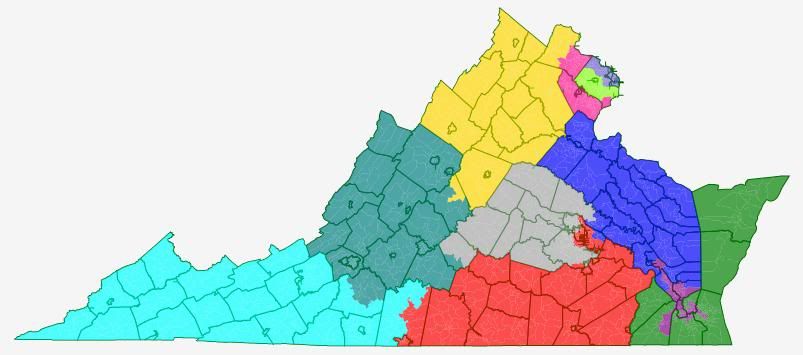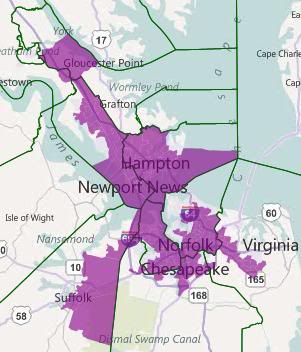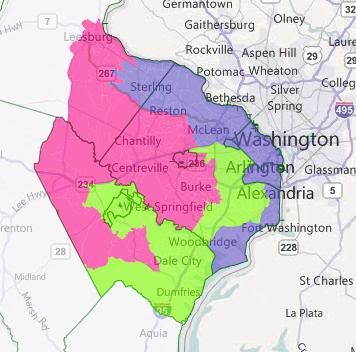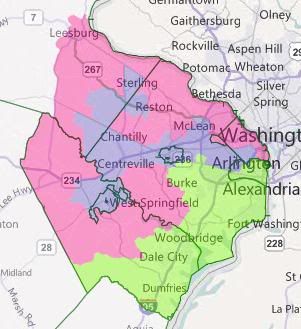Texas has always been, in my mind, the most interesting state for redistricting in 2010, partly because it grew much more than any other state (it gained four seats, while no other state gained more than two), and partly because much of that growth was Hispanic. This sets up a major conflict in the redistricting process: the Republicans, who control the trifecta here, will want to draw as many of those four new seats for themselves as possible, obviously, but the Obama administration’s Dept. of Justice, via the Voting Rights Act, will compel the creation of as many majority-minority seats as possible. Given the numbers that came out today, Texas Republicans may actually feel lucky getting away with two of the four new seats… assuming that’s what they end up with, after the conclusion of the inevitable litigation process that will result.
Texas gained a whopping 4,293,741 people between 2000 and 2010, growing from 20,851,820 to 25,145,561. Of that 4+ million, only about 10% were non-Hispanic whites. The non-Hispanic white population in 2000 was 10,933,313, and in 2010 it’s 11,397,345, a difference of 464,032. Contrast that with the growth in Hispanics, who went from 6,669,616 to 9,460,921, a gain of 2,791,305. Expressed as percentages, Texas now has only a plurality, not a majority, of non-Hispanic whites. They make up 45.3% of the population in 2010, along with 11.5% non-Hispanic blacks, 3.8% non-Hispanic Asians, and 37.6% Hispanics. (In 2000, non-Hispanic whites were 52.4%, along with 11.3% black, 2.7% Asian, and 32% Hispanic. Those don’t add up to 100 because there are also categories for Native Americans, Pacific Islanders, two or more races, and “some other” race.)
With Texas about to expand to 36 seats, that means the target average for each new congressional district will be 698,488. Here’s a chart that looks at each current congressional district, giving old and new populations, the amount gained (or lost), and the “deviation,” which is what we’re calling how many people each district will need to shed (or in a few cases, gain) in order to hit its 2010 target. (In case you’re wondering, yes, the 2000 data is for the post-2004 DeLay-mander configurations of each district.) I’m also including the 2000 and 2008 presidential election results, so you can see which direction the districts are headed (very different, when you contrast the trend in rural east Texas districts with suburbs for the major cities).
| District | Rep. | 2000 total | 2010 total | Total change | Deviation | 2000 election | 2008 election |
|---|---|---|---|---|---|---|---|
| TX-01 | Gohmert (R) | 651,652 | 723,464 | 71,812 | 24,976 | 33/68 | 31/69 |
| TX-02 | Poe (R) | 651,605 | 782,375 | 130,770 | 83,887 | 37/63 | 40/60 |
| TX-03 | Johnson, S. (R) | 651,782 | 842,449 | 190,667 | 143,961 | 30/70 | 42/57 |
| TX-04 | Hall (R) | 651,500 | 846,142 | 194,642 | 147,654 | 34/66 | 30/69 |
| TX-05 | Hensarling (R) | 651,919 | 725,642 | 73,723 | 27,154 | 34/66 | 36/63 |
| TX-06 | Barton (R) | 651,691 | 809,095 | 157,404 | 110,607 | 34/66 | 40/60 |
| TX-07 | Culberson (R) | 651,682 | 780,611 | 128,929 | 82,123 | 31/69 | 41/58 |
| TX-08 | Brady (R) | 651,755 | 833,770 | 182,015 | 135,282 | 31/69 | 26/74 |
| TX-09 | Green, A. (D) | 651,086 | 733,796 | 82,710 | 35,308 | 69/31 | 77/23 |
| TX-10 | McCaul (R) | 651,523 | 981,367 | 329,844 | 282,879 | 34/67 | 44/55 |
| TX-11 | Conaway (R) | 651,590 | 710,682 | 59,092 | 12,194 | 25/75 | 24/76 |
| TX-12 | Granger (R) | 651,770 | 831,100 | 179,330 | 132,612 | 36/64 | 36/63 |
| TX-13 | Thornberry (R) | 651,665 | 672,781 | 21,116 | (25,707) | 26/74 | 23/77 |
| TX-14 | Paul (R) | 651,837 | 779,704 | 127,867 | 81,216 | 36/64 | 33/66 |
| TX-15 | Hinojosa (D) | 651,580 | 787,124 | 135,544 | 88,636 | 54/46 | 60/40 |
| TX-16 | Reyes (D) | 652,363 | 757,427 | 105,064 | 58,939 | 59/41 | 66/34 |
| TX-17 | Flores (R) | 651,509 | 760,042 | 108,533 | 61,554 | 32/68 | 32/67 |
| TX-18 | Jackson-Lee (D) | 651,789 | 720,991 | 69,202 | 22,503 | 72/28 | 77/22 |
| TX-19 | Neugebauer (R) | 651,610 | 698,137 | 46,527 | (351) | 25/75 | 27/72 |
| TX-20 | Gonzalez (D) | 651,603 | 711,705 | 60,102 | 13,217 | 58/42 | 63/36 |
| TX-21 | Smith (R) | 651,930 | 856,954 | 205,024 | 158,466 | 31/69 | 41/58 |
| TX-22 | Olson (R) | 651,657 | 910,877 | 259,220 | 212,389 | 33/67 | 41/58 |
| TX-23 | Canseco (R) | 651,149 | 847,651 | 196,502 | 149,163 | 47/54 | 51/48 |
| TX-24 | Marchant (R) | 651,137 | 792,319 | 141,182 | 93,831 | 32/68 | 44/55 |
| TX-25 | Doggett (D) | 651,477 | 814,381 | 162,904 | 115,893 | 47/53 | 59/40 |
| TX-26 | Burgess (R) | 651,858 | 915,137 | 263,279 | 216,649 | 38/62 | 41/58 |
| TX-27 | Farenthold (R) | 651,843 | 741,993 | 90,150 | 43,505 | 50/50 | 53/46 |
| TX-28 | Cuellar (D) | 651,259 | 851,824 | 200,565 | 153,336 | 50/50 | 56/44 |
| TX-29 | Green, G. (D) | 651,405 | 677,032 | 25,627 | (21,456) | 57/43 | 62/38 |
| TX-30 | Johnson, E. (D) | 652,261 | 706,469 | 54,208 | 7,981 | 74/26 | 82/18 |
| TX-31 | Carter (R) | 651,868 | 902,101 | 250,233 | 203,613 | 32/69 | 42/58 |
| TX-32 | Sessions (R) | 650,555 | 640,419 | (10,136) | (58,069) | 36/64 | 46/53 |
Now let’s turn to the changes in racial composition in each district. The Hispanic population increased in all of Texas’s 32 districts, with the smallest increase being 35,816 (in TX-32 in north Dallas, the only district which lost population overall – I’m not quite sure why this district lost population, other than the fact that it’s fairly dense, and boxed in by other urban districts, so it’s unable to sprawl in any direction). Eight districts gained more than 100,000 Hispanics each, with the biggest gain in the Laredo-based TX-28, gaining 166,375. The second biggest gain was 159,747 in TX-10, the wormlike district that links Houston’s western suburbs with Austin’s eastern suburbs and which gained a whole lot of everybody of all races. TX-10 is also more remarkable in that the Hispanic share of the total population nearly went up 10%, from 19% to 29% (by contrast, in TX-28, the Hispanic share barely increased, seeing as how they’re already the vast majority there).
These two existing districts point to where two of the new VRA districts are likeliest to pop up: the Rio Grande Valley, and the Houston area. (A new Hispanic-majority Houston seat would probably be located in the downtown and western parts of town, pushing TX-07 and then TX-10 further west.) The third possibility is a Dallas area Hispanic-majority seat, which might be anchored in downtown and western Dallas but wander further west to grab areas near DFW airport and maybe even in Fort Worth. The GOP, I’m sure, would prefer to try to limit the number of VRA seats to two, but it may be a difficult balancing act; in particular, it’ll be hard to avoid having a new VRA seat pop up in the Rio Grande Valley (thanks to huge growth in TX-15 and TX-23, too) if they’re going to try to reconstruct a more Republican-favorable TX-27 in order to protect unexpected new member Blake Farenthold (maybe linking Corpus Christi with Victoria instead of Brownsville, for instance).
| District | 2000 white | White % | 2010 white | White % | % change | 2000 Hispanic | Hispanic % | 2010 Hispanic | Hispanic % | % change |
|---|---|---|---|---|---|---|---|---|---|---|
| TX-01 | 485,238 | 74.5 | 514,939 | 71.2 | -3.2 | 59,688 | 9.2 | 109,499 | 15.1 | 6.0 |
| TX-02 | 462,830 | 71.0 | 493,830 | 63.1 | -7.9 | 82,578 | 12.7 | 176,196 | 22.5 | 9.8 |
| TX-03 | 467,828 | 71.8 | 539,627 | 64.1 | -7.7 | 111,121 | 17.0 | 186,890 | 22.2 | 5.1 |
| TX-04 | 540,477 | 83.0 | 666,802 | 78.8 | -4.2 | 50,410 | 7.7 | 110,993 | 13.1 | 5.4 |
| TX-05 | 505,283 | 77.5 | 523,328 | 72.1 | -5.4 | 83,113 | 12.7 | 157,037 | 21.6 | 8.9 |
| TX-06 | 477,168 | 73.2 | 537,602 | 66.4 | -6.8 | 103,380 | 15.9 | 185,397 | 22.9 | 7.0 |
| TX-07 | 505,703 | 77.6 | 529,586 | 67.8 | -9.8 | 117,392 | 18.0 | 198,587 | 25.4 | 7.4 |
| TX-08 | 553,472 | 84.9 | 686,659 | 82.4 | -2.6 | 58,820 | 9.0 | 128,027 | 15.4 | 6.3 |
| TX-09 | 213,041 | 32.7 | 240,882 | 32.8 | 1.1 | 213,195 | 32.7 | 310,931 | 42.4 | 9.6 |
| TX-10 | 490,353 | 75.3 | 676,833 | 69.0 | -6.3 | 122,894 | 18.9 | 282,641 | 28.8 | 9.9 |
| TX-11 | 523,788 | 80.4 | 577,078 | 81.2 | 0.8 | 192,811 | 29.6 | 257,633 | 36.3 | 6.7 |
| TX-12 | 505,402 | 77.5 | 635,292 | 76.4 | -1.1 | 154,032 | 23.6 | 239,268 | 28.8 | 5.2 |
| TX-13 | 526,737 | 80.8 | 544,719 | 81.0 | 0.2 | 114,488 | 17.6 | 157,732 | 23.4 | 5.9 |
| TX-14 | 491,492 | 75.4 | 588,513 | 75.5 | 0.1 | 162,778 | 25.0 | 226,440 | 29.0 | 4.1 |
| TX-15 | 504,686 | 77.5 | 674,927 | 85.7 | 8.3 | 506,447 | 77.7 | 649,297 | 82.5 | 4.8 |
| TX-16 | 483,295 | 74.1 | 620,074 | 81.9 | 7.8 | 507,249 | 77.8 | 617,465 | 81.5 | 3.8 |
| TX-17 | 512,489 | 78.7 | 585,982 | 77.1 | -1.6 | 100,241 | 15.4 | 157,049 | 20.7 | 5.3 |
| TX-18 | 240,569 | 36.9 | 281,511 | 39.0 | 2.1 | 231,548 | 35.5 | 313,533 | 43.5 | 8.0 |
| TX-19 | 502,156 | 77.1 | 549,589 | 78.7 | 1.7 | 188,932 | 29.0 | 235,973 | 33.8 | 4.8 |
| TX-20 | 425,519 | 65.3 | 500,530 | 70.3 | 5.0 | 437,800 | 67.2 | 509,208 | 71.5 | 4.4 |
| TX-21 | 531,029 | 81.5 | 680,337 | 79.4 | -2.1 | 138,599 | 21.3 | 240,713 | 28.1 | 6.8 |
| TX-22 | 464,216 | 71.2 | 557,629 | 61.2 | -10.0 | 132,379 | 20.3 | 244,900 | 26.9 | 6.6 |
| TX-23 | 467,321 | 71.8 | 672,404 | 79.3 | 7.6 | 423,648 | 65.1 | 562,913 | 66.4 | 1.3 |
| TX-24 | 476,428 | 73.2 | 488,398 | 61.6 | -11.5 | 116,586 | 17.9 | 214,851 | 27.1 | 9.2 |
| TX-25 | 439,574 | 67.5 | 584,962 | 71.8 | 4.3 | 220,942 | 33.9 | 315,776 | 38.8 | 4.9 |
| TX-26 | 474,910 | 72.9 | 652,345 | 71.3 | -1.6 | 93,451 | 14.3 | 193,973 | 21.2 | 6.9 |
| TX-27 | 495,162 | 76.0 | 623,615 | 84.0 | 8.1 | 443,919 | 68.1 | 543,306 | 73.2 | 5.1 |
| TX-28 | 518,245 | 79.6 | 748,669 | 87.9 | 8.3 | 505,754 | 77.7 | 672,129 | 78.9 | 1.2 |
| TX-29 | 357,764 | 54.9 | 398,350 | 58.8 | 3.9 | 430,980 | 66.2 | 514,861 | 76.0 | 9.9 |
| TX-30 | 238,931 | 36.6 | 256,028 | 36.2 | -0.4 | 223,200 | 34.2 | 280,508 | 39.7 | 5.5 |
| TX-31 | 477,328 | 73.2 | 647,694 | 71.8 | -1.4 | 106,121 | 16.3 | 195,753 | 21.7 | 5.4 |
| TX-32 | 439,551 | 67.6 | 422,818 | 66.0 | -1.5 | 235,626 | 36.2 | 271,442 | 42.4 | 6.2 |
Unfortunately, for some reason, while American Factfinder has “Hispanic or Latino by Race” available for entire states, the only data it currently has available at the CD level is the less precise “Race and Hispanic or Latino.” While that seems like a minor semantic distinction, this means there’s no way to parse out non-Hispanic white (and non-Hispanic black, etc.) for CDs. Bear in mind that “Hispanic,” for Census purposes, isn’t a race unto itself, but a box that gets checked in addition to race. So, while most people who check “Some other race” are Hispanic, not all Hispanics identify as “Some other race;” in fact, more than half of Hispanics identify as “white” (with most of the rest as “some other”) instead. This makes a big difference, in making the sample look whiter than it actually is (at least if one defines “white” in the narrow non-Hispanic sense). At the state level, in 2010, Texas appears as 70.4% white, 11.8% black, and 3.8% Asian in this format, in addition to 37.6% Hispanic. (Considering that adds up to 124%, it’s very confusing. Here, it’s also confusing because it makes districts with an already-large Hispanic majority look like they got even whiter, at the same time as they gained more Hispanics.) So, I’d focus more on the Hispanic column than on the white column in this table, and maybe I’ll revisit this when we get data on non-Hispanic whites.
More data over the flip…
Finally, here are tables for the African-American and Asian populations for each congressional district. While African-American growth is fairly slow (though seemingly faster than growth in non-Hispanic whites), the Asian growth in Texas is just as fast-paced as Hispanic growth (if not faster, in certain suburban districts).
| District | 2000 black | Black % | 2010 black | Black % | % change | 2000 Asian | Asian % | 2010 Asian | Asian % | % change |
|---|---|---|---|---|---|---|---|---|---|---|
| TX-01 | 120,705 | 18.5 | 127,714 | 17.7 | -0.9 | 3,256 | 0.5 | 6,487 | 0.9 | 0.4 |
| TX-02 | 124,420 | 19.1 | 168,647 | 21.6 | 2.5 | 16,395 | 2.5 | 26,501 | 3.4 | 0.9 |
| TX-03 | 59,496 | 9.1 | 97,376 | 11.6 | 2.4 | 54,246 | 8.3 | 102,783 | 12.2 | 3.9 |
| TX-04 | 67,155 | 10.3 | 87,583 | 10.4 | 0.1 | 4,300 | 0.7 | 17,420 | 2.1 | 1.4 |
| TX-05 | 80,743 | 12.4 | 100,881 | 13.9 | 1.5 | 10,365 | 1.6 | 14,086 | 1.9 | 0.3 |
| TX-06 | 83,081 | 12.7 | 134,647 | 16.6 | 3.9 | 21,819 | 3.3 | 32,795 | 4.1 | 0.8 |
| TX-07 | 36,603 | 5.6 | 78,428 | 10.0 | 4.4 | 44,670 | 6.9 | 79,224 | 10.1 | 3.3 |
| TX-08 | 56,930 | 8.7 | 65,401 | 7.8 | -0.9 | 5,098 | 0.8 | 11,934 | 1.4 | 0.6 |
| TX-09 | 244,295 | 37.5 | 262,525 | 35.8 | -1.7 | 69,533 | 10.7 | 79,853 | 10.9 | 0.2 |
| TX-10 | 59,420 | 9.1 | 111,799 | 11.4 | 2.3 | 25,383 | 3.9 | 57,124 | 5.8 | 1.9 |
| TX-11 | 26,925 | 4.1 | 28,410 | 4.0 | -0.1 | 3,527 | 0.5 | 5,222 | 0.7 | 0.2 |
| TX-12 | 36,133 | 5.5 | 56,115 | 6.8 | 1.2 | 14,963 | 2.3 | 24,464 | 2.9 | 0.6 |
| TX-13 | 36,690 | 5.6 | 39,620 | 5.9 | 0.3 | 7,762 | 1.2 | 11,586 | 1.7 | 0.5 |
| TX-14 | 63,978 | 9.8 | 71,281 | 9.1 | -0.7 | 10,962 | 1.7 | 27,358 | 3.5 | 1.8 |
| TX-15 | 12,020 | 1.8 | 12,169 | 1.5 | -0.3 | 3,588 | 0.6 | 6,854 | 0.9 | 0.3 |
| TX-16 | 20,477 | 3.1 | 24,499 | 3.2 | 0.1 | 6,946 | 1.1 | 8,205 | 1.1 | 0.0 |
| TX-17 | 67,278 | 10.3 | 74,834 | 9.8 | -0.5 | 9,434 | 1.4 | 15,071 | 2.0 | 0.5 |
| TX-18 | 263,106 | 40.4 | 265,109 | 36.8 | -3.6 | 21,547 | 3.3 | 24,340 | 3.4 | 0.1 |
| TX-19 | 35,845 | 5.5 | 39,777 | 5.7 | 0.2 | 5,521 | 0.8 | 8,840 | 1.3 | 0.5 |
| TX-20 | 43,738 | 6.7 | 51,563 | 7.2 | 0.5 | 9,964 | 1.5 | 13,859 | 1.9 | 0.4 |
| TX-21 | 41,027 | 6.3 | 57,403 | 6.7 | 0.4 | 16,805 | 2.6 | 32,375 | 3.8 | 1.2 |
| TX-22 | 61,165 | 9.4 | 129,682 | 14.2 | 4.8 | 50,695 | 7.8 | 115,594 | 12.7 | 4.9 |
| TX-23 | 18,617 | 2.9 | 29,870 | 3.5 | 0.7 | 6,650 | 1.0 | 16,040 | 1.9 | 0.9 |
| TX-24 | 63,194 | 9.7 | 117,088 | 14.8 | 5.1 | 39,716 | 6.1 | 75,088 | 9.4 | 3.3 |
| TX-25 | 63,750 | 9.8 | 64,042 | 7.9 | -1.9 | 12,146 | 1.9 | 18,460 | 2.3 | 0.4 |
| TX-26 | 100,881 | 15.5 | 122,856 | 13.4 | -2.1 | 14,125 | 2.2 | 35,991 | 3.9 | 1.7 |
| TX-27 | 17,084 | 2.6 | 17,385 | 2.3 | -0.3 | 5,091 | 0.8 | 8,837 | 1.2 | 0.4 |
| TX-28 | 8,178 | 1.3 | 13,116 | 1.5 | 0.2 | 3,179 | 0.5 | 6,502 | 0.8 | 0.3 |
| TX-29 | 65,414 | 10.0 | 68,630 | 10.1 | 0.1 | 8,492 | 1.3 | 7,826 | 1.2 | -0.1 |
| TX-30 | 271,812 | 41.7 | 293,203 | 41.5 | -0.2 | 8,552 | 1.3 | 8,848 | 1.3 | 0.0 |
| TX-31 | 84,561 | 13.0 | 113,076 | 12.5 | -0.5 | 14,275 | 2.2 | 31,047 | 3.4 | 1.2 |
| TX-32 | 50,833 | 7.8 | 54,869 | 8.6 | 0.8 | 26,923 | 4.1 | 33,982 | 5.3 | 1.2 |






